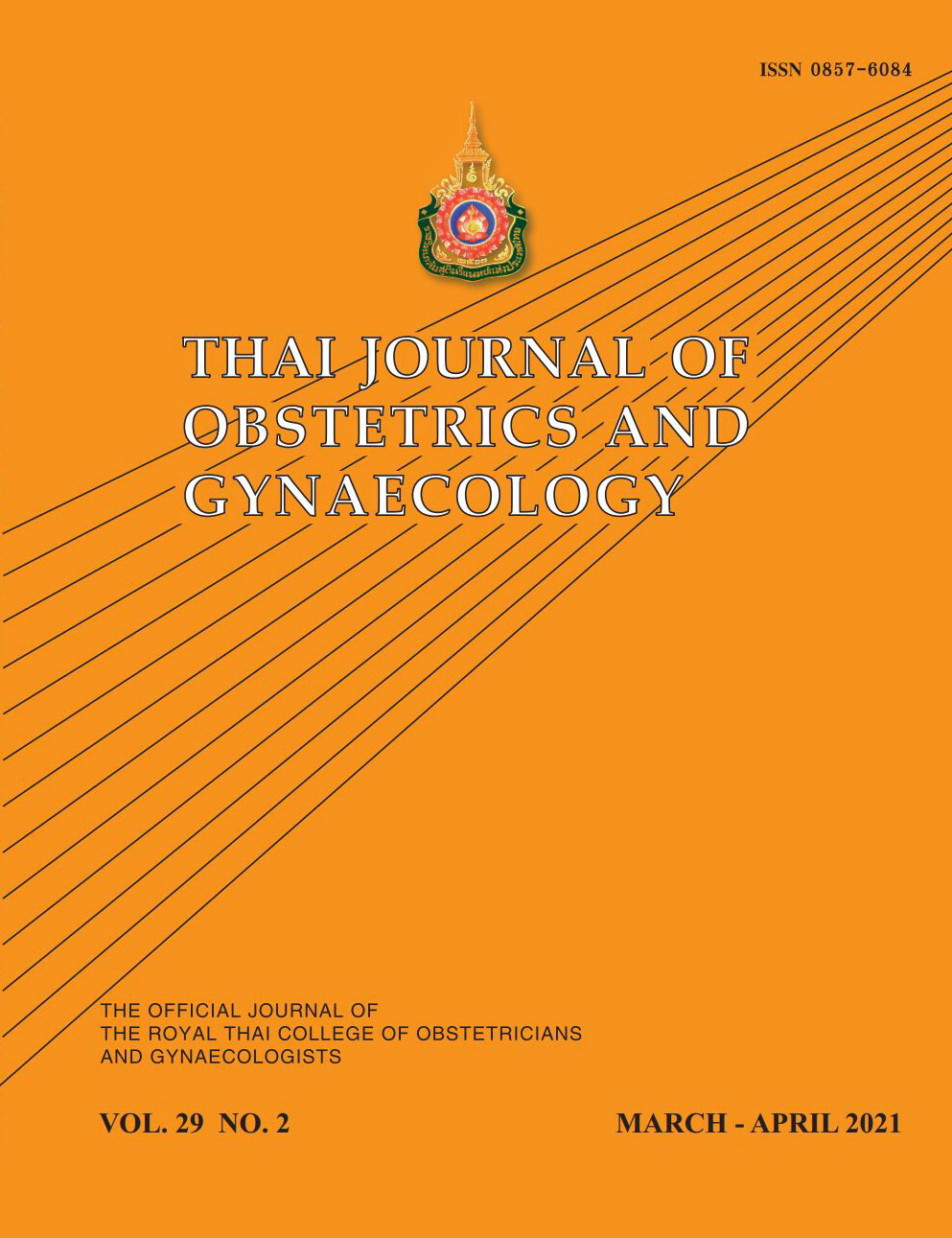Returning of Bowel Function in Early Versus Delayed Oral Feeding after Cesarean Delivery
Main Article Content
Abstract
Objective: To study the recovery time of the normal bowel function in early oral feeding patients after the cesarean delivery.
Materials and Methods: This Randomized Controlled Trial study included 140 term-pregnant women who had uncomplicated cesarean delivery under spinal anesthesia at Chonburi Hospital during December 26, 2018 - June 30, 2019. The patients were categorized into two groups: 1) the patients who experienced early oral feeding after 6 hours following the cesarean delivery and 2) the patients who received delayed oral feeding after 12 hours following the cesarean delivery. The sample size of each group was 70 (n = 70), collected via blocked randomization. The main purpose of this categorization was that to compare the time to first passage of flatus and defecation between these two group. In addition, the postoperative gestational complication and the patient’s satisfaction level (by SAPS score), which are regarded as the supporting outcomes, were collected.
Results: The study found that the mean time to first passage of flatus in early oral feeding group, which was 1485.29 ± 538.15 minutes (24.7±8.9 hours), was significantly shorter than the delayed feeding group, which was 2411.29 ± 451.51 minutes (40.1±7.5 hours), at 95 percent confidence level. Besides, the early oral feeding group produced the mean first defecation time of 2106.71 ± 582.98 minutes (35.1±9.7 hours) after the cesarean delivery, which was significantly shorter than the mean first defecation time of 3295 ± 553.89 minutes (54.9±9.2 hours) yielded by the delayed feeding group at 95 percent confidence level. Additionally, the patient’s satisfaction level in the early oral feeding group was higher than the other group; however, the more signs of nausea and vomiting symptoms were shown in the early feeding group.
Conclusion: The returning of the normal bowel function after the cesarean section in term-pregnant women under spinal anesthesia can be improved by starting the oral feeding after 6 hours following the cesarean section. However, the chance for undergoing the nausea and vomiting symptoms tends to be higher in patients who received the early feeding practice.
Article Details
References
2. Fanning J, Andrews S. Early postoperative feeding after major gynecologic surgery: evidence-based scientific medicine. American journal of obstetrics gynecology. 2001;185:1-4.
3. Mangesi L, Hofmeyr GJ. Early compared with delayed oral fluids and food after caesarean section. Cochrane database of systematic reviews. 2002.
4. Wilson RD, Caughey AB, Wood SL, Macones GA, Wrench IJ, Huang J, et al. Guidelines for antenatal and preoperative care in cesarean delivery: enhanced recovery after surgery society recommendations (part 1). American journal of obstetrics gynecology. 2018;219:523.
5. Saad AF, Saoud F, Diken ZM, Hegde S, Kuhlmann MJ, Wen TS, et al. Early versus late feeding after cesarean delivery: a randomized controlled trial. American journal of perinatology. 2016;33:415-9.
6. Adeli M, Razmjoo N, Tara F, Ebrahimzade S. Effect of early post cesarean feeding on gastrointestinal complications. Nursing midwifery studies. 2013;2:176.
7. Guo J, Long S, Li H, Luo J, Han D, He T. Early versus delayed oral feeding for patients after cesarean. International Journal of Gynecology Obstetrics. 2015;128:100-5.
8. Evans DM, McAree K, Guyton DP, Hawkins N, Stakleff K. Dose dependency and wound healing aspects of the use of tissue plasminogen activator in the prevention of intra-abdominal adhesions. The American journal of surgery. 1993;165:229-32.
9. Kalogera E, Dowdy SC. Enhanced recovery pathway in gynecologic surgery: improving outcomes through evidence-based medicine. Obstetrics Gynecology Clinics 2016;43:551-73.
10. Hawthorne G, Sansoni J, Hayes L, Marosszeky N, Sansoni E. Measuring patient satisfaction with health care treatment using the Short Assessment of Patient Satisfaction measure delivered superior and robust satisfaction estimates. Journal of clinical epidemiology. 2014;67:527-37.
11. Ituk U, Habib AS. Enhanced recovery after cesarean delivery. F1000Research. 2018;7.
12. ACOG Committee Opinion No. 750: Perioperative Pathways: Enhanced Recovery After Surgery. The American College of Obstetricians and Gynecologists. 2018;132: e120-30.


